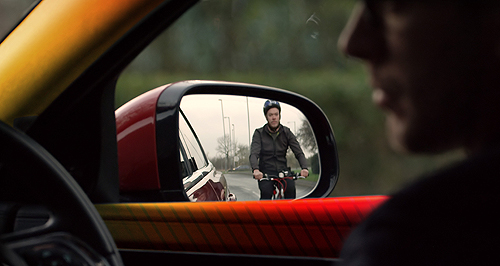Make / Model Search
News - JaguarJLR technology concept 'taps' driver's shoulderJaguar Land Rover Bike Sense tech triggers human instincts to prevent accidentsGallery Click to see larger images 21 Jan 2015 JAGUAR Land Rover is developing a Bike Sense detection system that uses a combination of lights, sounds and even tactile warnings to alert drivers when cyclists or pedestrians are within a potentially dangerous proximity of the car. Sensors placed around the car monitor activity in all directions and can tell the difference between people, cyclists, motorcyclists and other moving objects, even if the person is obscured by another vehicle, for example. The technology locks onto approaching cyclists and alerts the driver of their position with a series of moving yellow and red LED lights, and a bicycle bell sound played through the sound system. Using the multi-speaker audio system, the alert sounds as if it is coming from the location of the hidden cyclist, making the driver aware of the potential hazard quicker and more intuitively than conventional buzzers and instrument panel warnings, says JLR. The alert is also repeated through a dynamic part of the seat which can move and effectively tap the driver on the shoulder as a secondary warning. Drivers respond to his type of warning more instinctively, says JLR research and technology director Wolfgang Epple. "Human beings have developed an instinctive awareness of danger over thousands of years,” he said. “Certain colours like red and yellow will trigger an immediate response, while everyone recognises the sound of a bicycle bell. "Bike Sense takes us beyond the current technologies of hazard indicators and icons in wing mirrors, to optimising the location of light, sound and touch to enhance this intuition. “This creates warnings that allow a faster cognitive reaction as they engage the brain's instinctive responses. “If you see the dashboard glowing red in your peripheral vision, you will be drawn to it and understand straight away that another road user is approaching that part of your vehicle."As the cyclist comes into view, a red zone of light follows the hazard in the window sill, A-pillar and dashboard, keeping the driver informed of the danger until it is at a safe distance. Various forward facing sensors continue to monitor the road ahead of the vehicle and if the driver tries to accelerate before the hazard is clear, the accelerator pedal can vibrate and become heavier, informing the driver that it isn't yet safe to proceed. For situations when multiple hazards are present, the technology can prioritise the nearest relevant object so that the driver is not overwhelmed by too many lights and warnings. The system remains active even after the vehicle has been switched off to prevent the situation where a car door is opened into the path of a cyclist. Exit handles can detect if an occupant attempts to open the door and will vibrate and illuminate red if a cyclist is approaching, alerting the passenger that opening the door could be dangerous. The research is yet to result in a working prototype but with further development the 'concept technology' could evolve into technology available in production cars in the near future.  Read more6th of January 2015  Hyundai maps future tech at CESCES hosts Hyundai autonomous driving, new connectivity and control demonstrations22nd of December 2014  Volvo to unveil wearable cyclist safety techCloud-based system will keep Volvos and cyclists apart with app and smart helmet |
Click to shareJaguar articlesResearch Jaguar Motor industry news |

















Facebook Twitter Instagram